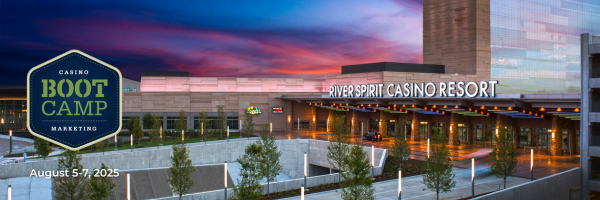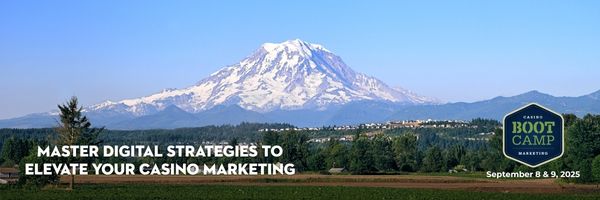It’s Wednesday at 2 PM, and your casino floor looks like a ghost town while your competitor down the road is packed for their “Senior Slot Wednesday.” Sound familiar?
You’re not alone. Regional casino marketing directors across the country are facing the same challenge: how to break through the noise when everyone is running the same playbook. Free play offers, birthday bonuses, and tier-based comps used to move the needle. Now? They’re table stakes that barely register with players who’ve seen it all before.
Meanwhile, your marketing budget hasn’t grown, your competition has multiplied, and your players are increasingly distracted by everything from sports betting apps to Netflix. The old tactics aren’t just stale—they’re actively being ignored.
What if you could outmaneuver your competitors without outspending them?
The answer isn’t bigger budgets or flashier billboards. It’s strategic creativity that taps into human psychology, community connections, and the element of surprise. The most successful regional casinos aren’t just marketing differently—they’re thinking differently about what marketing can be.
The Problem with Playing It Safe
Traditional casino marketing follows a predictable pattern: identify high-value segments, send targeted offers, track redemption rates, repeat. It’s data-driven, measurable, and forgettable.
Here’s what’s happening in your market right now:
- Every casino is targeting the same “premium” segments with similar offers
- Players are suffering from promotion fatigue—another 2X points Tuesday barely moves them
- Your marketing messages are lost in inboxes flooded with competitor offers
- The tactics that worked five years ago now feel tired and transactional
The casinos that are winning aren’t necessarily spending more. They’re spending smarter by creating experiences that feel fresh, personal, and worth talking about.
Strategy 1: The “Secret Player Profile” Mystery
Instead of generic segment promotions, gamify your database.
Rather than announcing “Top Tier Tuesdays,” run a “Secret Player Profile” day. Send out cryptic clues to your entire database: “You’ve been here twice this month, your favorite machine is Buffalo Gold, and you always order the chicken wings.” Players who recognize themselves and respond get a special reward.
Why it works: It transforms passive database segments into an engaging puzzle. Players feel seen and known, not just categorized. The mystery element creates buzz and social sharing as people try to figure out if they’re the target.
Implementation: Use your existing player data to create 3-5 specific profiles. Send clues via email and social media. Track responses and reward correct guesses with surprise comps or exclusive access.
Budget impact: Minimal—you’re utilizing existing data and standard communication channels.
Strategy 2: The “Lose & Win” Bounce-Back
Turn losing sessions into loyalty opportunities.
Most casinos only chase winners with follow-up offers. Flip this script by targeting players with tracked net losses. Send them a “We noticed your luck ran out—let us give you another shot” message with free slot play or a dining voucher.
Why it works: It softens loss aversion and creates a positive memory even after a disappointing visit. Players remember businesses that acknowledge their bad luck rather than just celebrating their wins.
Implementation: Set up automated triggers for players who exceed a certain loss threshold, but make the follow-up feel genuinely personal. Have your GM send actual handwritten notes that arrive within 2-3 days: “Hi Sarah, I noticed you had a rough night with us on Tuesday. That’s no fun at all. Here’s a little something to hopefully turn your luck around next time. – Mike, GM.” Include a modest but meaningful gesture, such as $20 in free play or a complimentary meal. Use a handwritten note service like Handwrytten to scale this, or have your GM write them personally during slow periods. In local markets, this is feasible.
Budget impact: Low—you’re converting existing loss data into goodwill and potential return visits.
Strategy 3: Hyper-Local Experience Partnerships
Transform your casino from a destination into a community hub.
Partner with niche local businesses for one-off experiences that feel fresh and connected to your market. Think “Slots & Savasana” with a local yoga studio, craft beer tastings with regional breweries, or “Haunted Slots” nights with local ghost tour operators.
Why it works: It positions your casino as part of the local fabric rather than just another gambling venue. These partnerships create cross-promotional opportunities and attract new demographics who might not typically visit casinos.
Implementation: Identify 3-5 local businesses with complementary but non-competing customer bases. Propose revenue-sharing partnerships where you provide the venue and gaming elements, and they provide the experience.
Budget impact: Revenue-neutral through partnerships—you’re sharing costs and profits while expanding your appeal.
Strategy 4: The “Whisper Network” VIP Treatment
Make mid-tier players feel like insiders.
Create an exclusive communication channel for frequent but mid-value players. This “backstage” email or SMS list offers flash opportunities, such as “2-for-1 drinks, tonight only” or “Secret slot tournament starting in 30 minutes.”
Why it works: Low and mid-tier customers rarely feel special in traditional casino marketing. It elevates their perception without requiring high-cost rewards. The exclusivity creates a sense of urgency and drives immediate action.
Implementation: Segment players who visit 2-3 times per month but don’t qualify for traditional VIP treatment. Establish a dedicated communication channel through private Facebook groups or WhatsApp chats for urgent, time-sensitive offers. The private group format enables players to build a community among themselves, share wins, compare strategies, and create organic buzz around your casino.
Budget impact: Minimal—you’re using existing communication tools to create perceived value through exclusivity.
Strategy 5: Community-Powered Promotions
Let your guests choose what happens next—and turn them into co-creators.
Instead of top-down promotional calendars, let players vote on upcoming offers, menu items, entertainment acts, or even new slot machine purchases via social media, email, or kiosks. This creates ownership and anticipation for events they helped select.
Why it works: It transforms customers from passive recipients into active participants in your brand experience. People are more likely to attend events they helped create, and they become unofficial ambassadors who tell friends, “I picked that!” The engagement doesn’t stop at voting—winners often become your most vocal promoters.
Implementation: Present 3-4 options per month across various categories. Let players vote on next month’s featured cocktail, choose between a classic rock cover band or a country tribute act, or decide whether your next promotion should be “Double Points Day” or “Mystery Bonus Wheel.” Create voting campaigns that feel like events themselves. Post teaser videos of the drink options, share audio clips of the bands, or create countdown posts building to the reveal.
Advanced twist: Give voters early access to the winning candidate. If they choose the new salmon dish, they get to try it first. If they pick the cover band, they get reserved seating. This creates multiple touchpoints and rewards participation beyond just voting.
Budget impact: Neutral—you’re still running the same promotions and events, just letting players influence the selection while creating additional engagement opportunities around the voting process.
Strategy 6: “Shift Break” Targeted Drops
Show appreciation for your local workforce—and capture them at the perfect moment.
Identify common shift-end times for local workers (nurses, teachers, factory staff, restaurant workers) and offer flash bonuses like “$10 free play between 4–6 PM for those clocking out” or “Teachers get $20 free play on Fridays after 3 PM with school ID.” Build campaigns around showing appreciation for essential workers while targeting them when they’re looking to decompress.
Why it works: It targets an overlooked segment with empathy-based messaging that feels genuine rather than promotional. Essential workers appreciate recognition, and the timing is ideal, capturing them as they transition from work stress to personal time. You’re not just offering a deal—you’re providing a stress-relief outlet at the exact moment they need it.
Implementation: Research the major employers in your area and their shift schedules. Create targeted campaigns for specific industries, such as “Nurses Week Special,” “Teachers’ Friday Wind-Down,” or “Third Shift Heroes” for overnight workers. Use workplace-specific language and timing that demonstrates your understanding of their schedule. Partner with local businesses near these workplaces to promote each other’s offerings. Coffee shops, uniform stores, or restaurants can help spread the word.
Advanced approach: Create “Shift Change Socials” where workers from the same industry can connect with others who understand their schedules. A “Nurses Night Out” creates community while driving group visits. Hospital workers on break can text friends still on shift about the great atmosphere.
Budget impact: Low—small offers targeted to specific windows create high emotional impact without significant expense. The community building often leads to increased frequency and friend referrals that multiply the initial investment.
Strategy 7: Gamify Your Non-Gaming Experiences
Turn every dollar spent into part of the game.
Transform your restaurants, spa, hotel, or gift shop into loyalty challenges that extend the casino excitement beyond the gaming floor. Create campaigns like “Dine 3 times this month and spin the prize wheel,” “Stay 2 nights, get entered to win a comped weekend,” or “Spend $100 in retail, unlock a mystery bonus.”
Why it works: It increases wallet share across your entire property while making non-gaming amenities feel connected to the casino experience. Players start viewing dinner or a spa visit as part of their overall gaming strategy, not separate purchases.
Implementation: Create punch cards or digital trackers for each amenity. Design spinning wheels or scratch-off reveals that maintain the excitement of gambling. Link achievements to gaming rewards—completing restaurant challenges could unlock slot tournament entries or VIP parking passes. Make the rewards feel casino-appropriate, not just discounts.
Advanced approach: Create cross-amenity challenges that encourage property exploration: “The Full Experience Challenge” might require one gaming session, one meal, and one retail purchase to unlock a grand prize entry.
Budget impact: Revenue-positive—you’re driving incremental non-gaming spend while the rewards come from gaming budgets or comped inventory.
Strategy 8: Nostalgia Nights – Full Experience Throwbacks
Transport players back to their golden memories.
Create immersive “Throwback Thursday” experiences that go far beyond just playing oldies music. Transform entire sections of your casino with decade-specific themes: ’70s disco nights with vintage cocktails and classic slots, ’80s neon parties with arcade games and retro appetizers, or ’90s nights with grunge music and comfort food classics.
Why it works: Nostalgia triggers powerful emotional responses and reconnects players with early casino memories when gambling felt fresh and exciting. It’s not just entertainment—it’s emotional time travel that makes your casino feel like a portal to better times.
Implementation: Choose a specific decade and commit fully to the experience. Decorate sections with period-appropriate elements, train staff on era-specific music and trivia, create custom cocktail menus with drinks from that time, and feature games that were popular during that decade. Encourage players to dress the part with costume contests and themed photo opportunities.
Advanced approach: Create “Decade Passports” where players collect stamps from different era nights throughout the year. Completing the passport unlocks access to an exclusive “Time Traveler’s Club” with special perks and advance notice of future themed events.
Budget impact: Moderate—decorations and themed elements require an upfront investment, but their experiential nature commands premium pricing and drives high social media engagement, extending the marketing value.
Strategy 9: Experiential Continuity Programs
Transform “pick up your gift” into “remember this forever.”
Instead of the traditional “send a postcard, stand in line to collect your reward” approach, create experiences around your continuity gifts that become events worth attending. Giving away perfume? Create a boutique atmosphere where guests can try fragrances and select their favorites with the help of a personal consultation. Offering cookware? Host a celebrity chef cooking demonstration, a VIP dinner, and serve the meal they’re preparing. Promoting luggage? Partner with a cruise line for an exclusive presentation where winners get passage for two on the cruise of their choice.
Why it works: It transforms transactional rewards into experiential memories that create emotional attachment to your casino. Instead of receiving a gift they might forget, players experience an event they’ll talk about for months. The experience itself becomes more valuable than the physical reward.
Implementation: For each continuity program reward, ask, “What experience could we create around this item?” Partner with local experts, vendors, or celebrities who can elevate the reveal. Create VIP atmospheres with proper staging, refreshments, and photo opportunities. Document everything for social media and future marketing materials.
Examples in action:
- Jewelry giveaway: Host a “Diamonds & Deals” evening with a gemologist explaining the pieces
- Electronics promotion: Create a tech showcase where winners test drive their prizes
- Home goods rewards: Partner with interior designers for mini-makeover consultations
- Gift card promotions: Turn them into “Shopping Spree Parties” with personal stylists
Budget impact: Moderate increase—experiences cost more than simple gift distribution, but dramatically improve perceived value, social sharing, and long-term loyalty. The experiential approach often allows for premium partnerships that offset costs.
Steal This Idea: The “Casino After Dark” Micro-Event
Here’s a complete campaign you can implement immediately:
The Concept: Instead of big promotional events, curate intimate themed evenings like “Whiskey & Wheel Night” or “Ladies Who Love Lightning Link.” Make them reservation-only with 50-person caps.
The Execution:
- Week 1: Send exclusive invitations to your top 100-150 players with cryptic messaging: “Something special is brewing for whiskey lovers… invitation only”
- Week 2: Reveal the event details to invitees only: “Whiskey & Wheel Night—exclusive tasting, private gaming area, 50 spots only”
- Week 3: Track RSVPs and create a waitlist for future events (this builds anticipation for the next one)
Event Night: Curated whiskey flight, dedicated roulette tables, sommelier host, networking atmosphere with your most valued players
The Follow-Up: Survey attendees about future themes. Create a waitlist for the next event. Document and share social proof.
Why it works: Exclusivity creates demand, themes allow for premium pricing, and intimacy builds stronger connections than mass events.
Budget: $500-$1,000 including alcohol, host fees, and promotional materials. Revenue potential: $2,000-$5,000 from gaming, food, and future visits.
What Not to Do: Common Pitfalls
The Copycat Mistake: Don’t transplant destination casino tactics to regional markets. Your players want local relevance, not Strip glamour.
The Influencer Trap: Avoid paying social media influencers without verifying that their audience actually gambles. A food blogger with 50K followers might generate zero casino visits.
The Complexity Overload: Don’t create promotions that require extensive explanation. If it takes more than one sentence to understand, it’s too complicated.
The “Spray and Pray” Approach: Resist the urge to try every new tactic simultaneously. Select one strategy, execute it effectively, and measure the results before moving on to the next.
The Discount Spiral: Don’t compete solely on offer size. Bigger bonuses without strategic thinking just erode margins without building loyalty.
Making It Happen: Your 30-Day Action Plan
Week 1: Choose Your Pilot. Select one strategy that aligns with your current capabilities and comfort level. The “Secret Player Profile” or “Whisper Network” approaches require minimal investment and use existing resources.
Week 2: Set Up Measurement. Define success metrics before launch. Track incremental visits, new player acquisition, social media engagement, and revenue per participant, not just redemption rates.
Week 3: Execute and Document. Launch your pilot with careful attention to player reactions, staff feedback, and operational smooth spots. Document everything for future optimization.
Week 4: Analyze and Iterate. Review results against your success metrics. What worked? What didn’t? What would you change? Use these insights to refine your approach or choose your next strategy.
The Bottom Line
Regional casino marketing doesn’t have to be a race to the bottom in terms of offer size or a copycat game of matching competitor promotions. The most successful operators are those who understand their local market deeply enough to create experiences that feel both familiar and surprising.
Your players don’t need bigger bonuses—they need reasons to care about your casino beyond the slot floor. They want to feel known, appreciated, and part of something special. The tactics that accomplish this often cost less than traditional promotions while creating stronger emotional connections.
Start small, think differently, and give your players something worth talking about.
The casino down the road might have deeper pockets, but they don’t have your creativity, your local connections, or your willingness to try something new. In a world of sameness, the different stands out and wins.
Your Wednesday afternoon floor doesn’t have to stay empty. It just needs a reason for people to show up.





Recent Comments